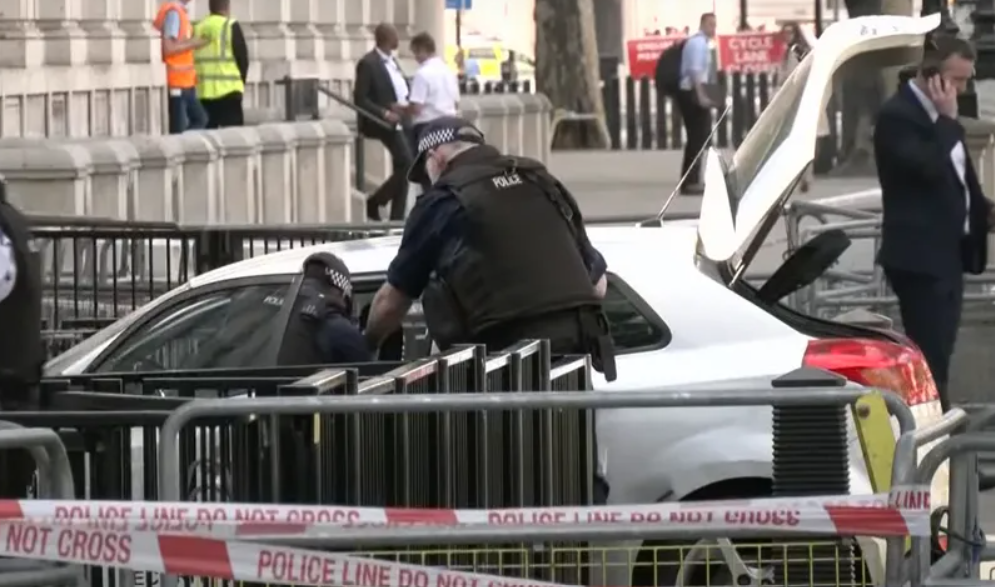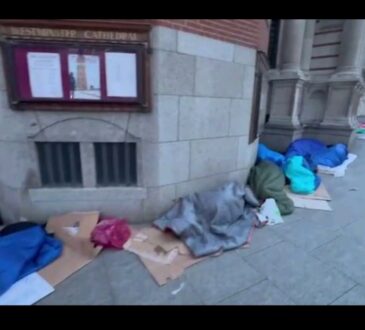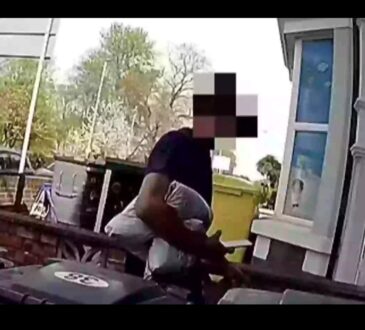“Silver Kia Hatchback Crashes into Downing Street Gates, Prompting Security Concerns and Arrest”

The bustling streets of London were met with a sudden and alarming incident as a silver Kia hatchback car careened into the imposing black iron gates of Downing Street. The unexpected crash sent shock waves through the area, capturing the attention of onlookers and igniting a flurry of activity. Eyewitnesses recall the dramatic sequence of events that unfolded before their eyes, recounting the car’s journey across the street, its gradual deceleration as it approached the iconic Downing Street, and the deafening impact as it forcefully rammed into the sturdy gates.
Despite the relatively low speed of the collision, panic quickly spread among the gathered crowd, prompting a swift evacuation of the vicinity. The chaotic scene left pedestrians scrambling for safety, seeking refuge from the unfolding chaos. The exact origin of the ill-fated vehicle prior to its arrival at Downing Street remains a matter of speculation, leaving investigators puzzling over its trajectory and intent.
In the immediate vicinity, adjacent to the Ministry of Deference, the silver Kia hatchback appeared to be positioned at an angle outside a gated car park. The significance of this location raised questions, fueling speculations about any potential connections between the incident and the neighboring establishment. Authorities swiftly sprang into action, taking control of the situation and apprehending a man believed to be linked to the collision.

The individual in question, described as a middle-aged white man donning a white T-shirt, was promptly arrested on suspicion of criminal damage and dangerous driving. Law enforcement officers wasted no time in transporting the suspect to a central London police station, where he would undergo rigorous questioning as part of the ongoing investigation.
The Metropolitan Police released a statement confirming the arrest, stating, “At around 4.20 pm, a car collided with the gates of Downing Street on Whitehall. Armed officers swiftly responded, apprehending a man at the scene on suspicion of criminal damage and dangerous driving.”
Fortunately, reports indicate that no injuries were sustained as a result of the incident. However, the crash did raise concerns regarding the security and safety of prominent figures within Downing Street.
At the time of the collision, Rishi Sunak, the Chancellor of the Exchequer, was within the confines of Number 10, the official residence of the Prime Minister. Following the incident, Prime Minister’s security protocols were reviewed, prompting his departure from the premises for a scheduled engagement.
In the aftermath of the crash, a video emerged, capturing the sight of a convoy of cars swiftly departing from the rear exit of Downing Street.
This sudden development added another layer of intrigue to the already unfolding events. As a precautionary measure, Scotland Yard swiftly implemented a lock down in the surrounding area, effectively sealing off Whitehall. The heightened security presence, including the deployment of sniffer dogs and a firearms van, underscored the seriousness of the situation.

The authorities meticulously conducted their investigation, meticulously combing through the wreckage and subjecting the vehicle to thorough searches. In their pursuit of answers, officers painstakingly examined every detail, leaving no stone unturned.
Eyewitnesses, such as Simon Parry, shared their accounts of the incident, highlighting the presence of sniffer dogs and a bomb squad, further intensifying the atmosphere of uncertainty and apprehension that gripped the area. Parry recalled the contrasting reactions of individuals, with some fleeing in a state of panic while others appeared strangely excited amidst the chaos.
As the Metropolitan Police continue their exhaustive inquiries, the city of London remains on edge, seeking reassurance and answers in the wake of this startling event.
The ramifications of the crash at Downing Street are yet to fully unfold, but one thing is certain: the safety and security of the seat of power in the United Kingdom have come under scrutiny, prompting a reevaluation of existing protocols and measures to prevent similar incidents in the future.




